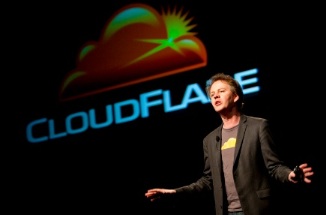
Editor’s Note: The following guest post is by Matthew Prince, CEO of a CloudFlare, which came in as a close runner-up at the last TechCrunch Disrupt. We asked him to give us an update on the startup since Disrupt.
It’s hard to imagine a web performance and security service “going viral,” especially one Mike Arrington described during the Disrupt awards ceremony as “Muffler Repair for the Internet,” but a glance through our Twitter feed gives credence to one of Silicon Valley’s axioms: if you make a great service that solves a real problem, users will come.
And come they have! While I have to confess our engineering team was initially bummed about losing to a demo of a website that could read Wikipedia articles aloud, I’m happy to report that they’ve channeled any frustration into building an incredible service that improves the lives of millions of web users every day.
A quick snapshot of the four months since our Disrupt launch:
- Tens of thousands of websites have signed up with CloudFlare to be faster and more secure
- We grew from a trickle of traffic to powering more than 1.2 billion monthly page views in January
- Nearly 3% of the Internet’s users (approximately 50 million unique monthly visitors) passed through our network last month
- By making sites faster (a 40% performance boost on average) we’ve helped Internet surfers collectively save nearly 1,000 years worth of time
- And we’ve stopped nearly 600 million attacks launched against our users’ websites
We’ve done no additional PR, marketing, or outreach since Disrupt and yet every day hundreds of new websites sign up for CloudFlare. From the Disrupt stage, we reached an incredible number of users worldwide. Today, the websites on the system span the globe from San Francisco (where CloudFlareis headquartered), to Accra (where we power the Official Government Portal of the Nation of Ghana), to Islamabad (where we power the Pakistani version of the IRS). We power sites for actors (Michael Rooker), popular bands (Counting Crows & Jack Johnson), and ecommerce shops like the one belonging to Lisa Freede. Lisa is a jewelry designer who was featured on The Today Show earlier this week. We’re proud that CloudFlare kept her site online and taking orders in spite of the staggering traffic generated by her appearance on the show.
Beyond introducing CloudFlare to the world, TechCrunch Disrupt was the event that really brought our team together. We actually launched the service live on stage in front of thousands of Silicon Valley’s thought leaders. That’s pressure. Nothing motivates better than a little fear, and knowing we would soar or crash in front of a live, influential audience had us all cranking for the months leading up to Disrupt. Even as I was back stage, the CloudFlare engineering team was in the audience with a list the final 27 bugs that needed to be fixed. I watched our IM channel as our team banged through the problems. When Michelle and I stepped on stage, they were down to 8. By the time we stepped off, they squashed the last few, flipped the switch, and we were live across five data centers on three continents.
No one on our team will ever forget the experience. If you’re a startup thinking of launching at Disrupt, that’s the only way to do it. You may not win the trophy, but you’ll receive something else far more important.
Our team is growing fast, we have a new office in downtown San Francisco, and we all still come to work each day excited to solve real, meaningful, hard problems. While we may just be doing “Muffler Repair for the Internet,” it turns out the Internet’s muffler is broken and needs fixing. And, as you’ll see from the video below, we’re having a great time while getting that done.






























Comment